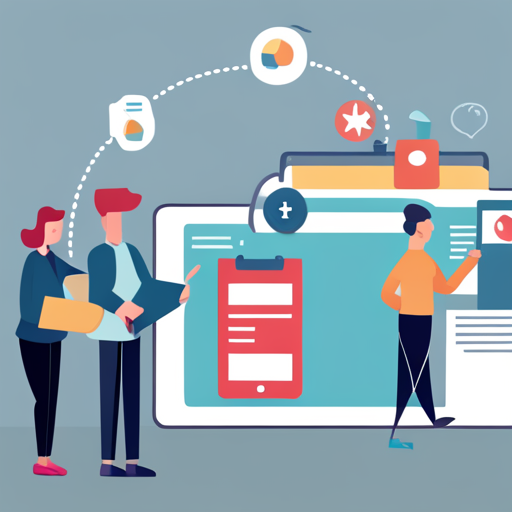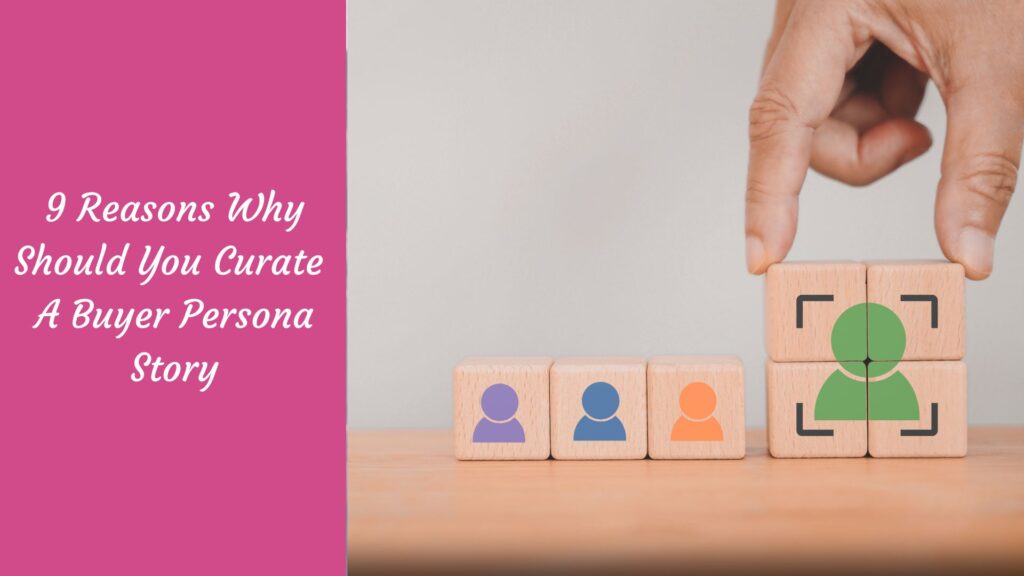SaaS or software-as-a-service businesses face numerous challenges in reaching out to their target audience. With fierce competition out there, it’s crucial to create a USP that sets you apart. And that’s where the power of a buyer persona story comes in.
Imagine having a vivid description of your ideal customer – someone who not only becomes your client but also advocates for your brand. In this blog post, we will unveil 9 compelling reasons why you should curate a buyer persona story that can skyrocket your SaaS business to new heights. Get ready to transform the way you connect with your audience!
What is Product storytelling?

Product storytelling is a narrative technique that businesses use to help consumers connect with their products or services on a deeper level. It involves telling a story about your product that resonates with your audience’s experiences, values, or aspirations.
Here are some examples of why you should curate a buyer persona story:
- Apple Inc.: Apple doesn’t just sell technology; it sells experiences and a lifestyle. The ‘1984’ Super Bowl advertisement is a classic example of product storytelling where they positioned themselves as a symbol of counterculture, rebellion, and individualism.
- Nike: Nike tells stories of athletes who overcome challenges. They don’t just sell sportswear; they sell the idea of perseverance, ambition, and achievement. Their tagline, “Just Do It,” is a story in itself, inspiring people to push their limits.
- TOMS Shoes: Every pair of TOMS shoes comes with a story of giving. The brand’s storytelling emphasizes its One for One initiative, where for every pair of shoes purchased, a pair is provided to a child in need. This narrative has attracted customers who value social responsibility.
These are just a few examples of how product storytelling has been an effective marketing tool for successful brands. But how can creating a buyer persona story help your SaaS business? Let’s find out.
9 Reasons Why Crafting a Buyer Persona Story Can Boost Your SaaS Business
Here is why you should curate a buyer persona story:

Helps You Understand Your Customers Better

Curating a buyer persona story helps you get an in-depth understanding of your customer’s needs, preferences, and behaviors. This, in turn, can help you tailor your SaaS products and services to meet the requirements of your target audience.
Helps You Create Products and Services That Satisfy Your Customers’ Needs

A buyer persona story can help you gather accurate data about your target audience, which you can use to create products and services that satisfy their needs. When your customers can find exactly what they need, they will keep coming back to your business, generating high loyalty levels and word-of-mouth referrals for your brand.
Helps You Craft Marketing Messages That Resonate With Your Target Audience

Creating a buyer persona story can help you develop messages that resonate with your target audience. You can use your buyer persona story to guide your marketing messages, which, in turn, will help you get better results from your marketing campaigns.
Provides Insights Into Potential Pain Points

Curating a buyer persona story will help you understand the pain points experienced by your target audience. You can use this information to identify areas where your SaaS products and services can offer value and provide solutions.
Helps You Focus Your Marketing Efforts

Curating a buyer persona will help you focus your marketing efforts on the customers with the highest potential for revenue generation. Instead of targeting everyone, you can save resources by targeting those who are more likely to buy your products and services.
Provides Strategic Direction
Curating a buyer persona story provides strategic direction for your SaaS business. You can use the buyer persona story to prioritize your product roadmap, your content strategy, and your marketing efforts, ensuring that you always stay on track.

Helps You Build Customer Relationships
Create a buyer persona story to personalize your marketing approach. This builds meaningful relationships with your customers, who will appreciate it.

Enhances Decision Making
A buyer persona story provides you with data about your target audience, which you can use to make informed decisions. By curating a buyer persona story, you will be able to gain insights about your target audience that can be used to make better business decisions that position your SaaS business for success.

Boosts Conversions

Curating a buyer persona story helps increase conversions by giving you insights into what resonates with your target audience and helping you craft a message that speaks to their unique needs. By doing so, you can move your audience through the sales funnel more efficiently and drive conversions even higher.
7 Best Practices for Product Storytelling

- Create a relatable protagonist: Consumers are more likely to connect with stories that feature characters they can relate to. For instance, Apple often showcases regular users in their product stories to emphasize usability and user-friendly design.
- Leverage the power of emotion: Emotional storytelling can have a profound impact on your audience. For example, Google’s “Dear Sophie” ad campaign tugged at the heartstrings of many viewers, creating a solid emotional connection with the brand.
- Show, don’t tell: Make use of visuals to convey your product’s benefits. An excellent example is Airbnb’s user-generated content, where actual users share their experiences through photos and videos, offering an authentic view of the service.
- Highlight the transformation: Show how your product can solve a problem or improve the user’s life. Dollar Shave Club, for instance, emphasizes how their subscription service makes shopping for razors convenient and cost-effective.
- Keep it simple: A good product story is straightforward to understand. Think of Tesla’s story – they’re not just selling cars; they’re selling a sustainable future.
- Align with your brand values: Ensure your product story aligns with your overall brand story and values. Patagonia does this well with product stories that emphasize sustainability and environmental stewardship.
- End with a call-to-action (CTA): The goal of storytelling is to inspire your audience to take action. For example, TOMS shoes always end their product stories with a clear CTA about their One-for-One giving program.
FAQs
How can I use a buyer persona story to better understand my customers?
- Identify Demographics: By crafting a buyer persona story, you get a more precise understanding of the demographics of your target audience. For instance, you might find that your typical customer is a female professional in her 30s.
- Understand Pain Points: Persona stories can highlight customer pain points, helping you better cater to their needs. An example might be a small business owner struggling to manage their company’s finances, which could be a perfect fit for your financial management software.
- Discover Motivations: You can use personal stories to identify what motivates your customers. Perhaps your buyer persona is an eco-conscious consumer who prefers brands that prioritize sustainability, like Patagonia.
- Empathize With Their Journey: Understanding the customer journey is crucial to improving your product or service. For instance, a first-time home buyer’s story would entail the excitement and nervousness of this significant life event, which could inform how a mortgage lender approaches their marketing messaging.
- Refine Product Positioning: By comprehending your customers’ needs and wants through their stories, you can tailor your product’s positioning. If your primary buyer persona is a busy parent, a meal kit service like Blue Apron might emphasize the convenience and time-saving aspects of their offering.
- Shape Marketing Strategies: Persona stories can guide the development of marketing strategies to resonate with your target audience. For example, if your persona is a technophile, a tech company might focus on showcasing cutting-edge features in their promotional campaigns.
What are the key benefits of creating a buyer persona story?
- Targeted Messaging: With a well-crafted buyer persona story, you can tailor your messaging to address their specific needs and desires. For instance, if your persona is a health-conscious consumer, your marketing messages could emphasize the nutritional benefits of your product.
- Enhanced Customer Engagement: Buyer persona stories can help create content that resonates more deeply with your audience, leading to increased engagement. A brand like Yeti might share stories about outdoor adventuring to connect with their outdoorsy, adventure-seeking customer base.
- Streamlined Product Development: Understanding your buyer persona’s needs and challenges can inform and improve product development. Suppose your persona is a busy business professional, for example. In that case, a productivity app company might focus on developing features that save time or streamline tasks.
- Improved Customer Retention: By deeply understanding the customer experience through their story, you can anticipate and address issues before they become problems, leading to greater customer satisfaction and retention. A software company, for instance, might prioritize user-friendly interfaces and responsive customer support based on their persona’s stress points.
- Efficient Resource Allocation: With a clear idea of who your customers are, you can use resources more effectively, targeting the most productive channels and strategies. An online fashion retailer targeting millennials, for instance, might invest more heavily in social media marketing rather than traditional advertising platforms.
How can I create a buyer persona story that is authentic and relatable?
Creating an authentic and relatable buyer persona story involves understanding your customers on a deep, personal level. This often involves market research, customer interviews, surveys, and social media listening to gather valuable insights.
For instance, let’s say you run a boutique fitness studio, and your target persona is “Busy Mom Maria,” a working mother who struggles to find time for exercise. Your persona story could detail her daily struggle of balancing work, family, and personal health. This story should reflect Maria’s challenges, motivations, and needs.
Perhaps Maria wakes up early, gets her kids ready for school, works a demanding job, and then comes home to cook dinner and manage household tasks. Despite her busy schedule, Maria is determined to stay healthy and active. She is looking for a fitness solution that is quick, effective, and can fit into her jam-packed schedule.
Your marketing messages could then emphasize how your fitness studio offers express classes or virtual options, allowing Maria the flexibility she needs.
Remember, the key to a relatable and authentic persona story is to echo the natural voice of your customers and address their specific needs and pain points. This approach will make your customers feel understood and valued, thus forging a stronger connection between them and your brand.
What types of information should I include in my buyer persona story?
In creating your buyer persona story, it’s crucial to include specific details that truly bring your persona to life. A compelling persona story is more than just a collection of demographic details; it’s a vivid snapshot of your ideal customer’s life, their dreams, frustrations, and needs.
- Demographic Information: This typically encompasses age, gender, income, location, and occupation. For example, “Busy Mom Maria” might be a 35-year-old working mother living in suburban Chicago, earning a middle-class income.
- Motivations and Goals: What drives your persona? What are their dreams and aspirations? For Maria, her motivation might be to maintain a healthy lifestyle while balancing work and family responsibilities.
- Challenges and Pain Points: What problems is your persona facing? Identifying these can help you position your product or service as a solution. Maria’s main challenge is likely finding time to fit exercise into her busy schedule.
- Behavior Patterns: How does your persona make decisions? Do they do extensive research before making a purchase? Do you prefer online shopping or in-person? Maria, being a busy mom, might prefer shopping online for convenience.
- Shopping Preferences: What influences your persona’s purchasing decisions? Maria, for instance, might be influenced by online reviews and word-of-mouth recommendations from fellow moms.
- Media Consumption: Where does your persona spend their time online? Understanding their media habits can guide your marketing strategy. Maria might frequent parenting blogs or follow fitness influencers on Instagram.
Remember, the goal is to paint a complete, empathetic picture of your buyer persona that will enable you to tailor your marketing efforts to their specific needs and preferences.
How can I use my buyer persona story to guide my business decisions?
- Product Development: Use your buyer persona’s pain points to guide your product development. For instance, knowing Maria struggles to find time for fitness, you could create a series of quick, compelling home workout videos.
- Marketing Strategy: Tailor your marketing message to address your persona’s motivations and goals. In Maria’s case, emphasize how your product fits seamlessly into a busy lifestyle.
- Content Creation: Generate content that meets your persona at their media consumption points. If Maria follows fitness influencers on Instagram, consider collaborating with these influencers for greater visibility.
- Customer Support: Equip your support team with your buyer personas to better understand and serve your customers. If Maria prefers online shopping, ensure your website is user-friendly, and your online support is readily available.
- Sales Alignment: Train your sales team to understand the buyer personas, helping them communicate effectively with potential customers. If Maria values online reviews, ensure your product garners positive testimonials.
- Brand Positioning: Position your brand in a way that appeals to your buyer persona’s values. If Maria is influenced by word-of-mouth recommendations, create a customer referral program.
Conclusion
Creating a buyer persona is a game-changing tool for SaaS businesses. By truly understanding the needs and preferences of your TG, you can tailor your products, services, and marketing messages to deliver exactly what they crave. 🎯
Unlocking a deeper understanding of your target market sets the stage for skyrocketing ROI, driving conversions, and ultimately achieving business success. Don’t wait any longer – start curating your buyer persona today! 💼✨

10+ years experience in Marketing and Operations

I don’t think the title of your article matches the content lol. Just kidding, mainly because I had some doubts after reading the article.